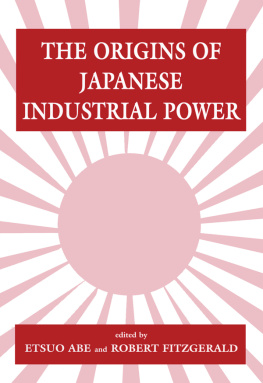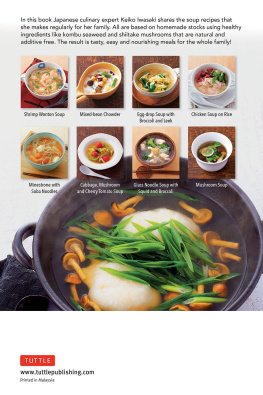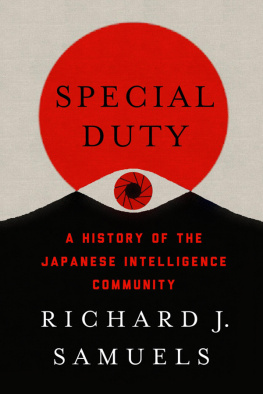First Published in 2001
by Routledge
2 Park Square, Milton Park, Abingdon, Oxon, OX14 4RN
711 Third Avenue, New York, NY 10017
http://www.routledge.co.uk
2001 Keiko Itoh
Typeset in Janson by LaserScript Ltd, Mitcham, Surrey
All rights reserved. No part of this book may be reprinted or reproduced or utilised in any form or by any electronic, mechanical, or other means, now known or hereafter invented, including photocopying and recording, or in any information storage or retrieval system, without permission in writing from the publishers.
British Library Cataloguing in Publication Data
A catalogue record of this book is available from the British Library
Library of Congress Cataloguing in Publication Data
A catalogue record for this book has been requested
ISBN 0700714871
Publishers Note
The publisher has gone to great lengths to ensure the quality of this reprint but points out that some imperfections in the original may be apparent.
Acknowledgements
Without the kindness and generosity of a number of individuals, this book would never have been possible. I owe a special thanks to Sadao Oba, who started me off in the right direction by sharing the sources he assembled over the course of his pioneering work on the Japanese in Britain. I am most indebted to those who provided the oral evidence, which forms the backbone of the book. In alphabetical order, they are: the late Shigeo Ataka, Mihoko Hamaoka, Noel John Hori, the late Shigeo Horie, Saburo Kimura, the late Xavier Koike, Shigeru Konno, Hisatsugu and Taeko Nakamura, Itsuko Nakamura, John Neill, Yoshio Okawa, Roy Hiroshi Oshima, Robin Otani, Edna Read, Rosina Saiko Said, Percy and Hana Sekine, Hidehiro Takaki, Mitsue Takaki, Tokuji Teraoka, Joyce Suga Unger, Moya Ward, Catherine Wu and John Chushi Yamanaka.
My parents, Rosa Hideko and Eikichi Itoh, have been the inspiration behind the book, having first met in London in 1934, and instilling in me since childhood a fascination and curiosity about the Japanese in pre-war Britain. My mothers help was essential in identifying and getting in touch with so many contributors to the book, and in recounting her experiences of life in Britain.
I will be forever grateful to the Economic History Department of the London School of Economics which took me on as a mature post-graduate student with a doctoral thesis topic that falls outside mainstream economic history. The stimulating and supportive environment provided by the LSE has been phenomenal. I am especially indebted to Janet Hunter and Dudley Baines, my supervisors, for their invaluable advice and encouragement. My thanks also go to the other LSE staff members and fellow students who helped me to clarify the issues and broaden my perspective during my research and writing.
Olive Checkland has been a most generous adviser, reading many parts of the manuscript, giving me her constructive views and welcoming me often at her home in Cambridge. Richard Bowen provided me with invaluable information on judo in Britain, and Yasushi Fukushima with information on tennis and golf in Japan. Noboru Koyama assisted me in obtaining a number of written sources, as did Yunosuke Okura. I am indebted to so many others who assisted in my search for difficult-to-find information. Among them are the late Kazuko Aso, Marie Conte-Helm, Sir Hugh Cortazzi, the late Tomohiko Hayashi, Ayako Hotta Lister, Setsuo Kato, Tsugumi Ota, Professor Ian Nish, Midori Nishiwaki, Sadaaki Numata, Shijuro Ogata, Phillida Purvis, Sir Julian Ridsdale, Pernille Rudlin, Kunio Sonoda, Yumiko Ueno, Momoko Williams, Elisabeth Wright and Yuko Yamagata. I am grateful to Professor Sheldon Garon for his advice and friendship. I owe thanks also to Linette and Keiko Hori, Winston Koike and Ryosuke Taoka who provided me with information on their families.
Peter Sowden of Curzon Press made possible the publication of this book, based on my PhD thesis. The Daiwa Anglo-Japanese Foundation helped me with a grant at the outset of my research. I was able to benefit from the collections and services of: the British Library, the Diplomatic Record Centre of the Japanese Ministry of Foreign Affairs, LSE Library, Japan Society Library, Osaka Prefectural Library, Public Record Office, Kew, Royal Academy Library, SOAS Library, Tokyo Municipal Library and the Victoria and Albert Museum Library. Photographs are reproduced with the kind permission of John Hori, Eikichi and Rosa Itoh, Hitoshi Katsurai, Yoshio Okawa, Rosina Said, Joyce Unger, Moya Ward, John Yamanaka, the Japan Society, The British Library and the Nippon Club. Nakabayashi Namiko and the families of Ezawa Shozo, Hoshino Hiroshi, Takahata Seiichi and Yamamoto Makiko kindly gave me permission to use excerpts from their memoirs.
Finally, a thank you to my husband, Tommy Helsby, for all his support on both intellectual and domestic fronts, and to my daughters Akiko Sophie and Anna Yukiko for never letting me forget there is far more to life than a PhD.











